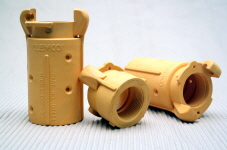RUBBER
INJECTION MOLDING
Material is mixed, typically in large batches, then stripped immediately after being mixed, into continuous strips. The strip is fed into a screw which charges a barrel as needed with a pre-defined amount of material. When the mold is closed, the material in the barrel is injected into the mold cavities and cured.
- Most efficient method to mold rubber
COMPRESSION MOLDING
Rubber compound or mixed raw material is made into “pre-forms” that are in the shape of the end product. These shapes are then loaded into an open mold. The mold is closed, forcing the material to fill the mold cavity. After the rubber is cured, it is removed from the mold.
TRANSFER MOLDING
An automated operation combining elements from both compression molding and injection molding processes where the amount of molding material is measured and inserted before the molding takes place. There is a secondary raw material step to prepare it into “pre-forms”. These “pre-forms” are preheated and loaded into a chamber, known as a sprue and runner, once the rubber cures. A plunger is raised up and the “transfer pad” material may be removed and thrown away. The transfer mold is opened and the part can be removed. The flash and gate may need to be trimmed.
- Good surface finish
- Good dimensional stability
- Good mechanical properties
- Suitable for smaller tolerances and more intricate parts
EXTRUSION
Material is pushed down or drawn through die of the desired cross-section. Can be done with hot or cold material.
- Can produce very complex cross-sections and work materials that are brittle because the material only encounters compressive and shear stress.
- Excellent surface finish.
RUBBER and METAL BONDING
Involves gluing rubber to metal by way of various adhesives. A mold is also used to give the rubber a certain shape when the rubber is bonded to the metal. The three main components are the rubber material, the bonding agent, and the metal substrate.
- Any type of rubber can be used, providing the material can flow into the mold.

